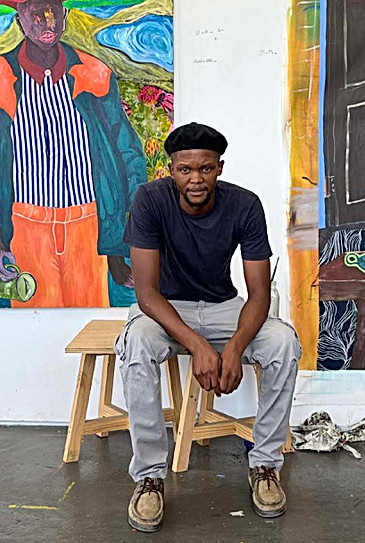Chumisa Fihla





Chumisa Fihla met Simphiwe Ndzube when he was younger, through his older brother, who was part of Ndzube’s dance group in Masiphumelele. Later, when Ndzube visited the Fihla home, he was impressed by a self-portrait the artist had made for his final matric exam at Fish Hoek High School and offered himself as Fihla’s guide going forward. Fihla’s work seeks to examine modern society and its shifts, focusing on the space traditional rituals now occupy and how they occur. He asserts the prevalence of African spirituality and mysticism in order to question the motivations behind it’s uses, whether it’s trendiness, power or malice. Using sculpture, painting and collage Fihla creates imagery that examines the past, the present and the future of belief. As a descendent of the Tshawe Xhosa royal family he was required to go to Tyume River in the Eastern Cape and learn more about spirituality and ancestors related to his family line. In being part of celebrations and ceremonies that featured bones, horns and other animal remains, taking place in living rooms, yards and hearths, he observed the relativity of sacredness, which connected to his thinking around art.
Gaining inspiration from Jane Alexander’s human-animal hybrid figures and Noah David’s surreal interiors, Fihla creates work that is both seductive and discomforting. Fihla employs direct symbolism in his work, with the bright colours intended to reflect hope and light, and the dark browns and blues alluding to the opposite. Candles and apples recur as motifs in the artist’s practice, with the former representing illumination and worship, and the latter - referencing the story of Adam and Eve in the Christian bible, alluding to mischief and disobedience.
Fihla works primarily as a sculptor and describes the move into painting as an opportunity for discovery. He explains: ‘I took a journey through my painting process. I wanted to find and heal myself. Since I have been a sculptor, I now try to give myself in the movement and flow of the brush.’
‘My larger-than-life sculpture depicts a figure as a passage between the living and the dead. Therefore, I use real animal bones and hair – once from a living creature. This is to show how sacrifices and ceremonial offerings speak to ideas of presence and absence.’